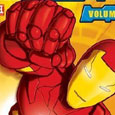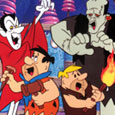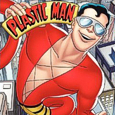Hanna-Barbera/Columbia Pictures (August 3, 1966), Warner Home Video (December 2, 2008), single disc, 89 mins, 1.33:1 original full frame ratio, Dolby Digital Mono, Rated G, Retail: $19.98
Storyboard:
The famous caveman takes the place of secret agent Rock Slagg in order to capture the Green Goose. Fred’s family and the Rubbles accompany him to Eurock, not knowing why Fred keeps being chased by a variety of women, or why he is acting so peculiar.
The Sweatbox Review:
There are some movies you love because they are great, and others that you love just because… well, just because. The Man Called Flintstone is not a great film, but there are so many things going for it that I can’t help but love it. It had been away from home video for many years, having come out once around 1990, when the original show was celebrating its 30th anniversary. I spent years trying to locate a copy, finally being rewarded when I happened to stop by a Wal*Mart in Boca Raton in 1994. I later picked up the laserdisc too, but now that a new DVD has been released, it will be easy for any Flintstones fan to discover this forgotten treasure. (Note: This DVD was released in Canada way back in March of 2005. Rights issues kept it out of the United States until now. It seems appropriately timed to follow up on the recent The Flintstones: The Complete Series set.)
The DVD cover emphasizes that this was the first theatrical Flintstones movie, dating back to 1966. This packaging idea was wise, as it is the film’s historical quality that lends much of its appeal. That is why I am amazed that it gets such little mention in books about Hanna-Barbera or The Flintstones. While 1964’s Hey There, It’s Yogi Bear was Hanna-Barbera’s first theatrical feature, The Man Called Flintstone is significant for being the first of many spin-offs from the famed TV show. The film was produced just as the series was finishing its original run after six hit seasons, the final episode airing that April 1.
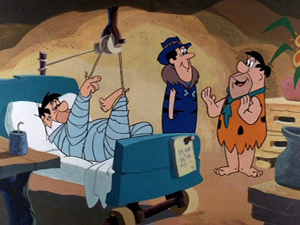
The idea was to cash in not only on The Flintstones, but also the popularity of the current spy craze. (In what cannot be a coincidence, another James Bond spoof with a very similar title came out the same year: Our Man Flint.) As happened in a few episodes of the show, cranky but lovable caveman Fred Flintstone would be found to be an exact double of another man. This time, instead of being asked to impersonate a tycoon or a king, Fred would have his chance to act the part of a super-spy. This territory had been explored previously in the great Dr. Sinister episode of the series (the one where Madame Yes refers to Fred as “you stupid good-looking”), but that story had the Hitchcockian element of Fred being caught up incidentally in events larger than him. The Man Called Flintstone would see Fred purposefully playing the role of secret agent, although with reservations.
The film runs about a minute under an hour-and-a-half— a bit less than four episodes’ worth of time. Unfortunately, the writers had only about two episodes’ worth of story, and the movie consequently is quite padded with songs that do little to advance the story. Still, it is a fun little production.
Those that have seen the movie previously on video will be sad to see that the original fun logo with Wilma appearing as the Columbia pictures lady is no longer there, having been taken out by Warner. Once we get past that, though, fans of the show will note immediately with the opening titles and first scene that special consideration was given to the theatrical environment that the movie would be shown in. The titles are a celebration of pop art, evoking comparisons to the kitschy work of Warhol, as a Goldfinger-inspired theme song plays. The story itself starts with a car chase in the mountains outside of Bedrock. The look is moody, with a simmering volcano in the background, and a fly-by by a pterodactyl that looks suspiciously like Turu from Jonny Quest. A man appearing to be Fred Flintstone (right down to his trademark clothes) is being pursued by a small, stout thug named Ollie, and a taller, fez-wearing thug named Bobo. As they conduct their chase through winding roadways, and we see Fred’s car go off a cliff, we get our first hint that that man is not Fred… when a parachute opens up from the car and carries the man safely down.
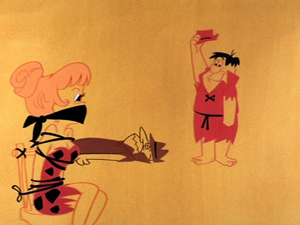
The chase continues into Bedrock on foot. Eventually, the man escapes but is badly injured. We find out he is “Rock Slag”, a secret agent who reports to Chief Boulder. (We also find out that anatomy is not his strong suit, as he grabs his hip while complaining of a twisted tibia— which is your shin bone!)
By this time, the increased production values have begun to fade, although the backgrounds remain a touch more detailed than on the show. The other interesting visual change is that Wilma’s dress is purple for the movie, rather than the usual white. I might assume that this is because white often does not show up well on a movie screen (I really noticed this when seeing Ice Age in the theater; I thought it looked awful, all grey and dreary, but was pleasantly surprised by how bright it was on DVD.)
Back to the story, we move to the next day and meet the real Flintstone and Rubble families. Dino and Hoppy are taken out of the story when Fred and Barney take them to the vet. The vet’s nurse, Miss Soapstone, adds an extra splash of sex appeal, looking somewhat more fetching than the girls on the TV series ever did. One of the last visual flourishes outside of the upcoming song numbers comes when Fred and Barney are seen driving in a three-quarter view shot, with the background animated. From here on, there is little to distance this movie from the television version of The Flintstones.
Perhaps it is the unusual viewing angle of Fred’s driving that leads to him crashing his car and ending up at the hospital. He is okay, but while there he is spotted by Chief Boulder, who desperately needs Fred to replace Rock Slag for a crucial mission. (Of course, before this happens we have to have a reprise of the ol’ “reflexes normal” gag with the doctor.) It seems that the “Green Goose” has a terrible weapon that needs to be neutralized, and the Goose’s henchwoman Tanya has agreed to betray the Goose if she can hook up with the suave Rock Slag. (If this had been produced a few years later, perhaps the title may have been The Spy Who Slagged Me?)
Fred takes an oath, promising to accept the mission but to reveal it to no one— not even his wife Wilma. One of the better musical sequences, “Spy Type Guy”, carries the pop art theme and has Fred dressed in the white trench coat seen in all the movie posters for the film. It’s a fun number, but its only purpose is to drag out the running time and remind everyone that this is not just another TV episode. Still, I like it.

Ollie and Bobo soon see Fred at the hospital and mistake him for Slag, which begins a series of confrontations that begin with Fred in jeopardy and end with either Fred accidentally escaping, or Ollie and Bobo coming to harm instead. The other running gag that starts up here concerns how Fred is suddenly extremely attractive to women, who think that he is Rock Slag. Naturally, this proves to be a complication later in the story when Fred takes his family and the Rubbles overseas to “Eurock”. Everyone thinks that Fred simply decided against their camping vacation, but of course he is secretly on his mission to meet Tanya and locate the Green Goose. Before we get there, though, we have to endure yet another song, “Teammates” that explores the friendship between Fred and Barney. I say “endure” because it does even less for the story and is not nearly as fun— visually or sonically— as the previous one.
Once in Paris, a better musical montage follows the story of Fred constantly escaping harm from Ollie and Bobo. Many of the bits are humorous, even if some are now a bit tired— think “Looney Tunes lite”. Then Fred hears from Chief Boulder again, who introduces Fred to the quick-change master Agent XXX, and informs Fred that he must now go to Rome. The gang goes along with the sudden alteration in plans. Wilma is thrilled by Fred’s new interest in romance, too, especially during another musical number “Pensate Amore” that shows a fantasy of Fred pursuing Wilma in Rome. This number could have also been edited out, except that it is notable for including vocals by the great Louis Prima (known to cartoon fans now for voicing King Louie in Disney’s 1967 adaptation of The Jungle Book). Otherwise, the song stops the progression of the movie absolutely cold.

Getting back to the story yet again, Fred is troubled by a succession of amorous women at a restaurant, while in the hotel room Pebbles and Bamm Bamm inexplicably enter into the most extraneous musical sequence of the movie, a “wishing” song that has nothing to do with the story. Oddly, much of the movie actually seems to forget about the tykes entirely, making one wonder which Eurockian babysitting service the Flintstones and Rubbles are using while all the action takes place.
Fred is then engaged in a chase (with the henchmen and a young lady and her brother) throughout Rome and the Italian countryside that makes him realize the danger he is in. He decides to quit, but Chief Boulder’s insistence that every child’s future is at stake makes him reconsider during—you guessed it— a musical sequence! This one is actually pretty decent, as it does make the point that Fred wants his little girl to grow up and follow her dreams. It is perhaps the most inventive sequence in the movie, too. Children sing the song, “Someday I’ll Be”, and the visuals use animation of drawings done in a child’s drawing style. The only drawback is that it does leave the real characters from the story behind, and could just have easily been a sequence from Sesame Street (had it been around then).

Okay, now for the wrap-up. I will not spoil things further, but Fred does finally meet Tanya, who is wearing a hat reminiscent of Hanna-Barbera’s Secret Squirrel, and takes on the Green Goose. I do have to note that Tanya and Wilma do have to share Fred briefly, leading to some typically fun Flintstones business. The finale at an abandoned amusement park was likely clichéd even then, but plays well in a nostalgic kind of way. In the end, I am pleased to say that Fred ends up a hero, a fitting way to end the original incarnation of The Flintstones, in their cinematic swan song.
Is This Thing Loaded?
Here’s the sad part. Warner Home Video did not see fit to bless this release with a single special feature. No trailer, no artwork, no nothing. At least we get chapter stops (which thankfully are NOT listed as special features on the cover!).
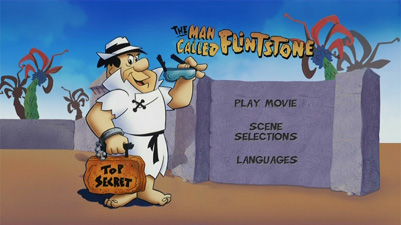
Case Study:
Standard keepcase.
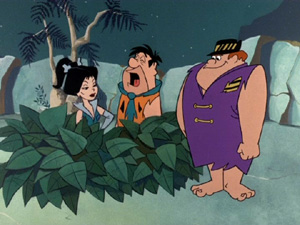
Ink And Paint:
The film is presented in the 4:3 ratio, with the cover insisting that this preserves the ratio of its original theatrical presentation. I have no reason to disbelieve that the film was originally shot 4:3 (regardless of how it may have been projected at various theaters). This is not unusual, as many kiddie matinee movies of the Sixties and Seventies were done in that ratio, as were many of Don Bluth’s animated films. At no time did I feel that any picture information was missing. Incidentally, the laserdisc was also in the 4:3 ratio.
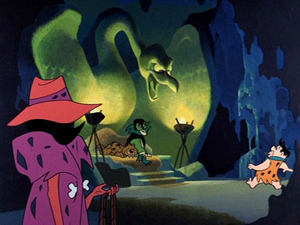
Numerous scratches and other markings mar this print. They improve slightly after the very tarnished opening credits, but it is quite clear that no serious restoration work was done for this movie. Given that, the compression work is very good, with no dot crawl, aliasing or edge enhancement noticeable.
Scratch Tracks:
There is not much to report here. The original English mono soundtrack is provided, sounding about as impressive as the television episodes. That is, it is thin and unimpressive, all staying within a mid-range of sonic expression, yet perfectly suited to the movie itself. There are also subtitles available in English, French, and Spanish.
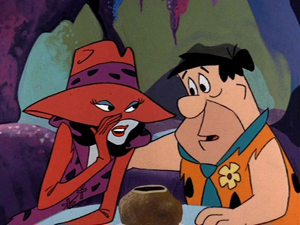
I might as well mention the voice actors here. Basically, the usual Flintstones cast is all here. Alan Reed provided the voice for Fred, but interestingly it was future “Fred” Henry Corden who provided the singing voice in this feature. Rock Slag was actually done by voice vet Paul Frees. Mel Blanc returned as Barney Rubble, and Jean Vander Pyl is again Wilma. The second “Betty”, Gerry Johnson, stays on; she had taken over the role from Bea Benaderet after season four. Harvey Korman does Ollie, the Chief, the Green Goose, and others, while Hanna-Barbera mainstay Don Messick also provides some voices. June Foray, in a role reminiscent of her “Natasha Fatale” from Rocky And Bullwinkle, provides the voice of Tanya.
Final Cut:
Okay, it has too many songs, the story drags because of it, and there is little else to separate this movie from the TV show. Nevertheless, we are talking about one of the great animated sitcoms here, and anyone who loves the show will want to check this movie out. When it works, it is a fun movie that has enough cleverness and whimsy to make for an enjoyable family evening. I do regret the lack of bonus material, and the loss of the Wilma/Columbia lady logo, but this is likely all we are getting. And if you decide you don’t like the songs, there’s always the “next chapter” function on your remote! If you bought the season sets, or the complete series set, you are probably a big Flintstones fan and should really pick this disc up too.
 | ||
 |








